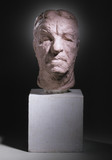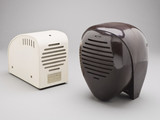Isamu Noguchi was one of the most significant sculptors to emerge in the period between the two world wars. The son of a Japanese poet and an American writer, Noguchi spent most of his early years in Japan. After returning to the United States in 1918, he was apprenticed briefly to the sculptor Gutzon Borglum (1867-1941) and then studied with Onorio Ruotolo (1888-1966) at the Leonardo da Vinci School of Art in New York. A Guggenheim Fellowship enabled Noguchi to travel in 1927 to Paris, where he served as a studio apprentice to Constantin Brancusi (18761957). In the early 1930s he visited Paris; Peking, where he studied brush drawing with Qi Baishi (1863-1957); and Japan, where he learned ceramics from Uno Jinmatsu. In the mid-1940s he began creating marble slab constructions, using abstracted biomorphic shapes, and associating his sculptures with myths. He also continued to sculpt in terracotta and ceramic. In the late 1950s he reintroduced into his art more angular, geometric shapes, and he also worked in metal, particularly aluminum.
Noguchi extended the boundaries of sculpture to include its use in the theater and as environmental works. The stage offered him a place to realize his imaginary environments. Best known for his collaborations with Martha Graham, which began in 1926, he continued to be involved in the theater until the early 1970s. His first designs for public spaces date from the mid-1930s and his landscape reliefs from the early 1940s, but none was realized until the early 1950s. The gardens and playgrounds enable people to experience sculpture directly as part of their everyday life. Selfilluminating sculpture, furniture, lamps, and interiors also occupied the artist as early as the 1940s.
In 1929 the Eugene Schoen Gallery in New York gave Noguchi his first solo exhibition. He had his first exhibition in London in 1934, in Japan in 1950, and in France in 1964. In 1942 the San Francisco Museum of Art organized his first museum exhibition, and in 1968 the Whitney Museum of Art gave him his first retrospective.
Noguchi established a studio in Japan in 1952 and commuted between there and New York. In the 1960s he established a studio in Long Island City, now the Isamu Noguchi Garden Museum. He remained productive, attracting many large-scale, private and public commissions, until his death.
BIBLIOGRAPHY
New York, Whitney Museum of American Art, Isamu Noguchi, exh. cat., 1968, published by Frederick A. Praeger, text by John Gordon, chronology; bibliography, lists of collections and exhibitions § Isamu Noguchi, A Sculptor’s World (New York: Harper & Row, 1968), with foreword by R. Buckminster Fuller § Sam Hunter, Isamu Noguchi (New York: Abbeville Press, 1978), with chronology, lists of exhibitions and awards, bibliography § Nancy Grove and Diane Botnick, The Sculpture of Isamu Noguchi, 1924-1979: A Catalogue (New York: Garland, 1980), with foreword by the artist, chronology, bibliography § Nancy Grove, "Isamu Noguchi: A Study of the Sculpture," Ph.D. diss., City University of New York, 1983, with bibliography.



